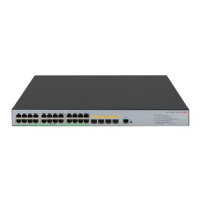131
Configuring PIM (available only on the
S5500-EI)
PIM overview
Protocol Independent Multicast (PIM) provides IP multicast forwarding by leveraging unicast static routes
or unicast routing tables generated by any unicast routing protocol, such as routing information protocol
(RIP), open shortest path first (OSPF), intermediate system to intermediate system (IS-IS), or border
gateway protocol (BGP). Independent of the unicast routing protocols running on the device, multicast
routing can be implemented as long as the corresponding multicast routing entries are created through
unicast routes. PIM uses the reverse path forwarding (RPF) mechanism to implement multicast forwarding.
When a multicast packet arrives on an interface of the device, it undergoes an RPF check. If the RPF check
succeeds, the device creates the corresponding routing entry and forwards the packet. If the RPF check
fails, the device discards the packet. For more information about RPF, see "Configuring multicast routing
and f
orwarding (available only on the S5500-EI)."
Based on the implementation mechanism, PIM falls into the following categories:
• Protocol Independent Multicast–Dense Mode (PIM-DM)
• Protocol Independent Multicast–Sparse Mode (PIM-SM)
• Bidirectional Protocol Independent Multicast (BIDIR-PIM)
• Protocol Independent Multicast Source-Specific Multicast (PIM-SSM)
The term "router" in this document refers to both routers and Layer 3 switches.
The term "interface" in this chapter collectively refers to Layer 3 interfaces, including VLAN interfaces
and Layer 3 Ethernet interfaces. You can set an Ethernet port as a Layer 3 interface by using the port
link-mode route command (see Layer 2—LAN Switching Configuration Guide).
PIM-DM overview
PIM-DM is a type of dense mode multicast protocol. It uses the push mode for multicast forwarding, and
is suitable for small-sized networks with densely distributed multicast members.
The basic implementation of PIM-DM is as follows:
• PIM-DM assumes that at least one multicast group member exists on each subnet of a network.
Therefore, multicast data is flooded to all nodes on the network. Then, branches without multicast
forwarding are pruned from the forwarding tree, leaving only those branches that contain receivers.
This flood-and-prune process takes place periodically. Pruned branches resume multicast

